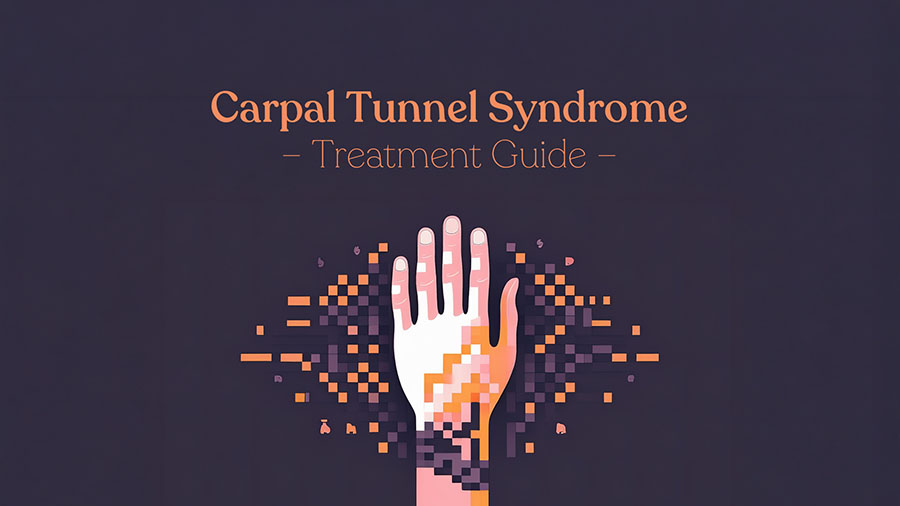If you are considering occupational therapy as a treatment for carpal tunnel syndrome, we want you to be as informed as possible—so we, as OTs, can truly partner to create the best course of treatment for YOU.
In occupational therapy, we tend to work from “menus” of evidence-based assessments and treatments. This gives us the flexibility to meet the specific needs of each patient. Below, you’ll find the assessment and treatment options your therapist may use, along with the evidence supporting them.

If your carpal tunnel syndrome symptoms are new (i.e., they began within the last two weeks) and mild enough that they are not occurring every day, you may want to first try some nerve gliding at home.
We’ve also included self-assessments to help you determine how much your carpal tunnel syndrome is impacting your quality of life—and whether it’s time to seek out therapy.
Please note that this page is for educational purposes and does not substitute advice from your medical provider. At the bottom of this page, you’ll find therapists near you who can support you in your carpal tunnel syndrome treatment.
A quick note on why to pursue therapy first
This article focuses on therapy treatment for carpal tunnel syndrome. As with most conditions, conservative treatment like therapy is typically the first course of care. That is because therapy is safer and much more cost-effective compared to invasive options like surgery (which come with a host of risks and potential complications—not to mention long recovery times).
Surgery for carpal tunnel syndrome can cost between $4,755–$8,923, whereas therapy typically costs $75–$150 per session.
About 90 percent of people who have undergone carpal tunnel surgery say they are happy with that decision. Depending on the severity and duration of your symptoms prior to surgery, it can take 3 to 4 months to recover—and up to 1 year before full hand strength returns. The amount of recovered hand strength will vary from person to person—and may also depend on how long symptoms were present prior to surgery (i.e., how compressed your nerve has been over time). Research indicates a quicker return to normal when therapy is part of the care process—ideally pre- and post-operatively.
The number and frequency of therapy sessions needed will vary based on your initial evaluation. In general, the higher your initial disability score, the more frequent your sessions. Ultimately, our goal as OTs is to move you toward self-management with a personalized prescribed program. (Read more about this in the discharge section below.)
Therapist-recommended assessments for carpal tunnel syndrome
As you can see below, evaluating a case of carpal tunnel syndrome involves much more than assessing the wrist itself. Other parts of the arm are often involved—even when your symptoms seem localized to the hand. The other benefit of a thorough examination is that it can help discern whether other diagnoses are contributing to your deficits.
Assessments also serve as a point of comparison for tracking your progress and response to treatment over time. An accurate and thorough baseline allows your therapist (and you!) to discern how much the interventions are helping. Your therapist may perform certain assessments at various intervals over the course of therapy.
Core Occupational Therapy Outcome Measures
Here are two metrics that many OTs collect with every patient. Our most-used assessment measures your quality of life. At the end of the day, this is the most important outcome for us. We want our treatments to have a significant impact on your day-to-day life.
- Quality of Life Patient Reported Outcome Measure- The PROMIS Global 10
- Grip Strength
More Possible OT Carpal Tunnel Syndrome Assessments
Patient Rated Outcome Measure → Administer at evaluation, re-evaluation, and discharge.
Observations
- Posture
- Muscles in the thenar eminence and forearm
Upper Quarter Screen
- Dermatomes, Myotomes, and Reflexes
Neurological Assessment
- Nerve Tension
- Semmes West Monofilaments to assess light touch 3
- Price for Full Semmes West starting at $258
- Price for Semmes West Minikit starting at $51
- Static 2-Point Discrimination 4
- Price starting at $49 on Amazon
Range of Motion
- Cervical ROM 5
- Shoulder ROM all planes
- Elbow ROM all planes
- Forearm ROM all planes
- Wrist ROM all planes
- Kapandji Score for thumb opposition 6
- Thumb Composite Flexion
Strength
- Grip Strength bilaterally 7
- Price of grip dynamometer is roughly $275 on Amazon
- Pinch Strength, including tip-to-tip, palmer, and lateral pinch
- Price is roughly $123 on Amazon
- Manual Muscle Testing
- Thenar eminence muscles
- Wrist flex/extend
- Elbow flex/extend
- Shoulder flex/abduct/ER/IR
Special Tests 8
- Durkan’s Test (a.k.a. Carpal Compression Test)
- Phalen’s Test for Carpal Tunnel
- Scratch-Collapse Test at Median Nerve Compression Sites in Upper Extremity 9
- Berger’s Test 10
- Differential Diagnoses
- Anterior Interosseous Nerve
- Pronator Syndrome/Lacertus Syndrome
- Thoracic Outlet Syndrome
- Cervical Radiculopathy
- Ganglion cyst
- CMC arthritis
- Double Crush
Setting goals for carpal tunnel therapy
Therapy only works when there is buy-in from the patient. It is important that you work with your therapist to set treatment goals that truly reflect what’s important to you.
Therapy treatment interventions for carpal tunnel
After a thorough evaluation and goal-setting process, it is time to start making progress. Below are treatment interventions that can be implemented as part of a holistic therapy program.
- Aerobic warm-up for endorphin release and to enhance axonal growth in adult dorsal root ganglion neurons when completed for a recommended 30 minutes, 4x/week 11
- Nighttime orthosis for 3–4 weeks in a neutral position
- One prefab option starting at $21: Med Spec Wrist Lacer
- One prefab option starting at $23: Rolyan D-Ring Wrist Brace
- Manual therapy: A neuropathic approach is recommended to improve space, movement, and blood flow for the nerve 12
- Instrument Assisted Soft Tissue Mobilization (IASTM) 13,14, 15
- Recommended multi-tool from Hawkgrips can be used on full body
- Priced at $595
- Recommended multi-tool from Hawkgrips can be used on full body
- Joint mobilizations: Mechanical interface approach following the nerve pathway 16, 17
- Instrument Assisted Soft Tissue Mobilization (IASTM) 13,14, 15
- Therapeutic exercise
- Tendon glides
- Finger and thumb extension
- Thumb opposition with a focus on “O” shape
- Wrist AROM
- Neurodynamic techniques that mobilize the nervous system and surrounding tissues 18 (more effective than surgery at improving pain)
- Median nerve mobilization 19
- Median nerve gliding 20
- Exercise to challenge nerve position/activity tolerance, focusing on provocative positions in the patient’s activities of daily living (ADLs)
- Median nerve mobilization 19
- Neuromuscular re-education to address coordination, proprioception, and motor planning
- Sensory re-education
- Stereognosis challenges
- Strengthening muscles innervated by the median nerve
- Sensory re-education
- Functional strengthening
- Wrist isotonics
- Scapular stabilization and postural control
- Core exercises
- Self-care home management and activity modification
- Lifting mechanics
- Ergonomic positioning and setup
- Energy conservation techniques
- Minimizing vibration impact
- For driving, the following options are recommended:
- Gel-padded bicycling gloves starting at $20
- Padded steering wheel cover (like this one for $15)
- For tool use, consider anti-vibration gloves, starting at $25
- For driving, the following options are recommended:
- Incorporating functional tasks based on patient goals
- Additional pain management tools
- Kinesiotape for carpal tunnel
- Starting at $14 on Amazon
- Modalities (ultrasound, e-stim, iontophoresis, TENS)
- Kinesiotape for carpal tunnel
- Home program
Discharge suggestions
Every person is unique, so your individual response to therapy will also be unique. For some, it is not appropriate to continue therapy until the condition completely resolves. For others, pain may resolve before the entire rehabilitation program is established. In the latter case, it is important to remember that pain is a symptom—not a diagnosis—and that strength and endurance deficits must be addressed to prevent recurrence. We also recommend that you:
- Follow your therapist’s discharge recommendations to maintain progress made in therapy.
- Continue to use self-management and empowerment strategies to control any remaining symptoms.
- Follow a home exercise program with a proximal posture component for an additional 3 months to help establish good habits for body mechanics, even if you feel like you’re back to 100% function.
- Consult your therapist immediately if your condition worsens, or if you continue to have difficulty with your daily activities after 3 months.
Choosing a therapist for carpal tunnel syndrome
Both occupational therapists and physical therapists can treat carpal tunnel syndrome. In less severe cases, a generalist therapist from either discipline should be able to help.
It is important to note that both OTs and PTs can pursue advanced certification as a Certified Hand Therapist. To achieve this rigorous specialization of the hand, wrist, elbow, and shoulder, therapists must log 4,000 hours of experience treating the upper extremity and pass a formal examination. They also must complete various recertification requirements every 5 years.
Below you can find occupational therapy professionals, who have tagged “hand therapy” as a focus area. The ones with a “CHT” in their credentials are Certified Hand Therapists.
Conclusion
Hopefully this article helped you understand what therapy for carpal tunnel syndrome entails—and whether you’re a good candidate for this type of treatment.
This article is updated once per month based on newly released research. If you have any research you would like us to consider, please drop it in the comments.
Therapists who would like more detailed information on carpal tunnel treatment best practices can join us as members of the OT Potential Club.

Article by
Rachel Egan, OTR/L, MS, CHT, COMT-UE, is an OT specializing in the upper extremity. In addition to caring for patients as a Certified Hand Therapist and Certified Orthopedic Manual Therapist, Rachel manages operations for 13 NovaCare clinics across Minnesota.

Reviewed by
Cheryl Zwerenz, OT, CHT, COMT (UL), is an experienced clinician, educator, and leader specializing in pediatrics and upper extremity rehab. Prior to founding Prestige Hand and Physical Therapy, she built and led the largest team of Certified Hand Therapists in the Kansas City metro area.
Edited by
Brooke Andrus is the Head of Content at OT Potential, bringing over a decade of experience strategizing, building, and executing on content marketing plans for successful healthcare tech startups in the rehab therapy and behavioral health spaces.
References
Here’s the science that backs the assessment and treatment outlined above.
- Shafiee E, MacDermid J, Farzad M, Karbalaei M. A systematic review and meta-analysis of Patient-Rated Wrist (and Hand) Evaluation (PRWE/PRWHE) measurement properties, translation, and/ or cross-cultural adaptation. Disability and Rehabilitation. 2022.
- Polson K, Reid D, McNair PJ, Larmer P. Responsiveness, minimal importance difference and minimal detectable change scores of the shortened disability arm shoulder hand (QuickDASH) questionnaire. Man Ther. 2010.
- Burke, S. L., Higgins, J. P., Mclinton, M. A., Saunders, R. J., & Valdata, L. Hand and upper extremity rehabilitation: A practical guide, 4th Edition. pp. 58-60. Elsevier. 2015.
- Hathaiareerug C., Ngamongard, P., Phonghanyudh T. Cutoff value of two-point discrimination distances in carpal tunnel syndrome. J Southeast Asian Med Research. 2020.
- Sukari AAA, Singh S, Bohari MH, Idris Z, Ghani ARI, Abdullah JM. Examining the Range of Motion of the Cervical Spine: Utilising Different Bedside Instruments. Malays J Med Sci. 2021.
- Kuroiwa T, Nimura A, Suzuki S, Sasaki T, Okawa A, Fujita K. Measurement of thumb pronation and palmar abduction angles with a small motion sensor: a comparison with Kapandji scores. J Hand Surg Eur Vol. 2019.
- Mathiowetz V, Kashman N, Volland G, Weber K, Dowe M, Rogers S. Grip and pinch strength: normative data for adults. Arch Phys Med Rehabil. 1985.
- MacDermid JC, Wessel J. Clinical diagnosis of carpal tunnel syndrome: a systematic review. Journal of Hand Therapy. 2004.
- Cheng CJ, Mackinnon-Patterson B, Beck JL, Mackinnon SE. Scratch Collapse Test for Evaluation of Carpal and Cubital Tunnel Syndrome. Journal of Hand Surgery. 2008.
- Cobb TK, An KN, Cooney WP, Berger RA. Lumbrical muscle incursion into the carpal tunnel during finger flexion. J Hand Surg Br. 1994.
- Molteni, R., Zheng, J., Ying, Z., & Twiss, J. L. Voluntary exercise increases axonal regeneration from sensory neurons. Proceedings of the National Academy of Sciences. 2004.
- Cook CE, Rhon DI, Bialosky J, Donaldson M, George SZ, Hall T, Kawchuck G, Lane E, Lavazza C, Lluch E, Louw A, Mazzieri AM, McDevitt A, Reed WR, Schmid AB, Silva AG, Smart KM, Puentedura EJ. Developing Manual Therapy Frameworks for Dedicated Pain Mechanism Journal of Orthopaedic & Sports Physical Therapy Open. 2023
- Gehlsen GM, Ganion LR, Helfst R. Fibroblast responses to variation in soft tissue mobilization pressure. Med Sci Sports Exerc. 1999.
- Davidson CJ, Ganion LR, Gehlsen GM, Verhoestra B, Roepke JE, Sevier TL. Rat tendon morphologic and functional changes resulting from soft tissue mobilization. Med Sci Sports Exerc. 1997.
- Burke J, Buchberger DJ, Carey-Loghmani MT, Dougherty PE, Greco DS, Dishman JD. A pilot study comparing two manual therapy interventions for carpal tunnel syndrome. J Manipulative Physiol Ther. 2007.
- Fernández-de-las-Peñas C, Cleland J, Palacios-Ceña M, Fuensalida-Novo S, Pareja JA, Alonso-Blanco C. The Effectiveness of Manual Therapy Versus Surgery on Self-reported Function, Cervical Range of Motion, and Pinch Grip Force in Carpal Tunnel Syndrome: A Randomized Clinical Trial. Journal of Orthopaedic & Sports Physical Therapy. 2017.
- Manual Techniques. In: Dutton M. eds. Dutton’s Orthopaedic Examination, Evaluation, and Intervention, 6e. McGraw Hill Education; 2023.
- Núñez de Arenas-Arroyo S, Cavero-Redondo I, Torres-Costoso A, Reina-Gutiérrez S, Álvarez-Bueno C, Martínez-Vizcaíno V. Short-term Effects of Neurodynamic Techniques for Treating Carpal Tunnel Syndrome: A Systematic Review With Meta-analysis. Journal of Orthopaedic & Sports Physical Therapy. 2021.
- Iogna Prat, P., Milan, N., Huber, J., & Ridehalgh, C. The effectiveness of nerve mechanical interface treatment for entrapment neuropathies in the limbs: A systematic review with metanalysis. Musculoskeletal Science and Practice. 2024
- Coppieters MW, Hough AD, Dilley A. Different nerve-gliding exercises induce different magnitudes of median nerve longitudinal excursion: an in vivo study using dynamic ultrasound imaging. Journal of Orthopaedic & Sports Physical Therapy. 2009
Additional References:
- Mohammadian M, Choobineh A, Haghdoost A, Hasheminejad N. Normative Data of Grip and Pinch Strengths in Healthy Adults of Iranian Population. Iran J Public Health. 2014.
OT Potential does not endorse any treatments, procedures, products, or therapists referenced herein. This information is provided as an educational service and is not intended to serve as medical advice. Anyone seeking medical advice should consult their medical provider.

